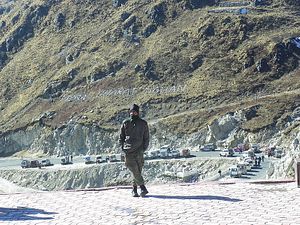This summer, Indian and Chinese troops were mired in a long-standing face off at Doklam – a once obscure patch of disputed territory between China and Bhutan.
In late August, both New Delhi and Beijing, with days to go before Indian Prime Minister Narendra Modi would meet Chinese President Xi Jinping at the BRICS summit in Xiamen, announced a mutual “disengagement” at Doklam.
In the days after, observers of the stand-off celebrated what was seen as the conclusion to the Doklam affair. However, nothing could have been further from the truth.
Today, the People’s Liberation Army (PLA) remains on disputed territory in Doklam, as does the Indian army. August’s “disengagement” was a reduction in tensions. In practice, troops on both sides retreated their positions from the stand-off point by 150 meters each.
Reporting clarifying this state of affairs at Doklam emerged some weeks after the “disengagement” was announced. In effect, this should somewhat dampen Indian celebrations about a tactical victory at Doklam.
Yes, New Delhi successfully attained an outcome where the PLA was unable to extend a road that terminated just 60 meters from the Indian border post at Doka La, but an extended and increasingly robust PLA presence at Doklam is foreboding.
For India, the prospect should be cause for concern. Even as the stand-off continues, heading into the harsh winter months, there is little prospect currently of a comprehensive diplomatic resolution.
The damage done over the course of the crisis at Doklam – particularly to bilateral agreements and understandings since 1993 – will have important spillover effects in the coming years.
While Xi and Modi were able to maintain face during their meeting in Xiamen, the mistrust generated in India over the duration of the Doklam crisis will linger, with implications for the development of bilateral ties.
It also remains to be seen if the conclusion of the ongoing 19th Party Congress in Beijing leads to an inflection point at Doklam in early November. While the PLA remains in place and with his power consolidated, Xi may emerge from the Congress with an elevated appetite for risk-taking.
For China, there are good reasons to keep up the heat at Doklam. First, the stand-off made plain to Beijing its quantitative and even qualitative disadvantages against the Indian armed forces in the Himalayas.
Beijing’s slow but steady build-up on the disputed plateau can serve as an opportunity to rectify this imbalance along this sector of the border, where Indian strategic planners remain particularly concerned given the proximity to the vulnerable Siliguri Corridor – a geographic choke point between northeast India and the rest of the country measuring just 23 km at its narrowest point.
The so-called “turning point” that served as the summertime epicenter of the stand-off is no more following the disengagement. Now, the PLA may look to buttress its position farther north, near China’s undisputed border with Bhutan in the southern reaches of the Chumbi Valley.
Even if matters at Doklam remain static for an indefinite duration, there is the renewed possibility of new PLA incursions in eastern Ladakh or Uttarakhand. Beijing may choose to test India’s patience in other sectors of the two countries’ disputed border.
The silver lining is that despite China’s insistence that India withdraw before diplomacy could take effect, the “disengagement” itself was the result of hard-fought negotiation. The mutually agreed sequential withdrawal was no doubt a positive reduction in the temperature at Doklam, but it remains unclear what concessions either side may be willing to offer to reach a more comprehensive agreement to put an end to the stand-off once and for all.
What should be clear is that the Doklam stand-off is far from over. What began presumably as a dispute over the extension of a road is now something far greater. It is a test of how India and China will come to manage their relationship and whether each can manage its ambitions in Asia without irreversibly thrusting the bilateral relationship into decline.
This article was originally published at the South China Morning Post. It is republished here with kind permission.

































